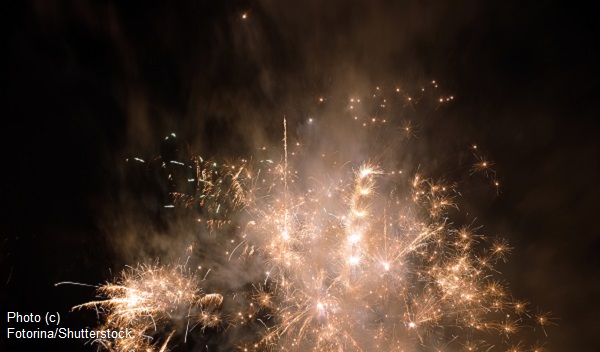|

The Toxic Consequences of Fireworks
by Wendy Priesnitz
The appeal of fireworks is huge. There is awe and excitement in watching those colorful, flickering lights arc overhead with such grace and energy. However, like so many things that glitter, fireworks have their ugly side. They pollute our air and water, and can endanger our health. Not only can their explosions frighten both domestic and wild animals, they can spark PTSD responses in war vets and civilians who have fled war zones, and damage hearing. And importantly, as the climate warms and wildfires destroy lives and property, they are increasingly seen as a fire hazard.
Fireworks get their appeal from a variety of chemicals, many of which are toxic and persistent in the environment. For the color effects, firework manufacturers use toxic heavy metals that can be carcinogenic or hormone-disrupting. These include barium, aluminum, cadmium, lead, lithium, mercury salts, antimony, copper, and strontium.
Gunpowder used to propel fireworks traditionally consists of charcoal, sulfur fuel, and potassium nitrate. Often, the potassium nitrate is replaced by perchlorates, which can, in high enough quantities, be carcinogenic and hormone-disrupting. A 2007 study of an Oklahoma lake following fireworks displays, that was published in the journal Environmental Science & Technology, found that perchlorate levels spiked more than 1,000 times above the baseline level for 14 hours after a show. Although the concentration was low, the study did illustrate that fireworks release perchlorates into waterways.
The smoke from fireworks explosions consists mainly of fine particulate matter that can easily enter the lungs, presenting an extra threat for people with asthma or multiple chemical sensitivities (MCS). The smoke normally contains a mixture of sulfur-coal compounds, traces of heavy metals, and other toxic chemicals or gases such as ozone, sulfur dioxide, carbon dioxide, and nitric oxide.
A study entitled “Particulate Oxidative Burden Associated with Firework Activity,” published in the journal Environmental Science & Technology in 2010 found that firework events brought air pollution spikes in suspended particles, nitric oxide, and sulfur dioxide, and created and dispersed an aerosol cloud hosting a range of metallic elements. The researchers noted that although the pollution from fireworks is transient in nature, the pollutants are highly concentrated and easily inhaled, and add significantly to total yearly metal emissions.
Another study from 2010, this time from India, estimated the probable health impact of exposure to the pollution caused by fireworks. Using risk data from epidemiological studies conducted in the USA, they estimated that when exposed to air pollution from fireworks the relative risk of cardiovascular mortality would increase as high as 125 percent over a regular winter day.
In 2001, researchers published a report entitled “Microclimate: Formation of Ozone by Fireworks” in the journal Nature. Their research found that fireworks can create a burst of the greenhouse gas ozone, which can irritate the lungs. The ozone is believed to be caused by ultraviolet light released by chemicals in fireworks, which in this study were sparklers.
A three-week study in London, published in Environmental Science & Technology, recorded two major festivals celebrated with pyrotechnic events and found that they were marked by increased gas phase pollutant levels of nitric oxide and sulfur dioxide, elevated parts-per-million concentrations, and trace metal concentrations, specifically strontium, magnesium, potassium, barium, and lead.
Those who are lighting fireworks themselves – aside from the large, professional displays – are at greater danger from the health effects because the smoke is released closer to the ground.
Add to this air, water, and noise pollution other fireworks fallout, such as plastic debris that contaminates water supplies, personal accidents like burns, and bush fires, and we have many important reasons to shun fireworks displays.
If you must persist with fireworks, check out those that use compressed air to launch them. Also avoid Chinese-made fireworks because of that country's pattern of using banned or more toxic chemicals. However, there are alternatives such as laser light shows and other electronic fireworks displays, as well as many other non-polluting ways of celebrating.
Wendy Priesnitz is the founding editor of Natural Life Magazine, and a writer with over 45 years of experience.
|

